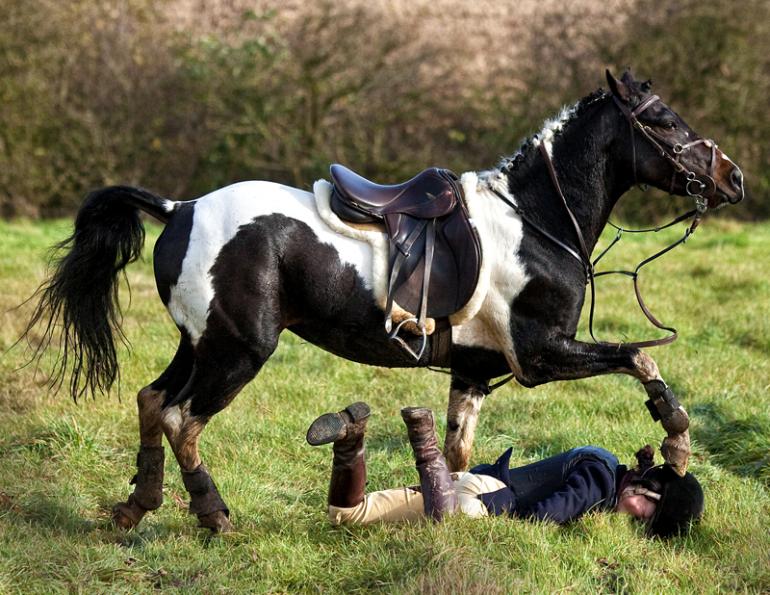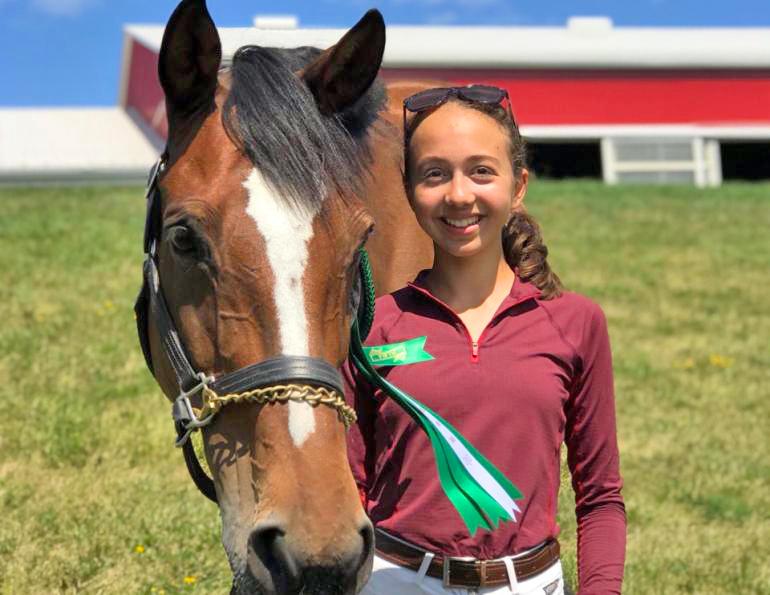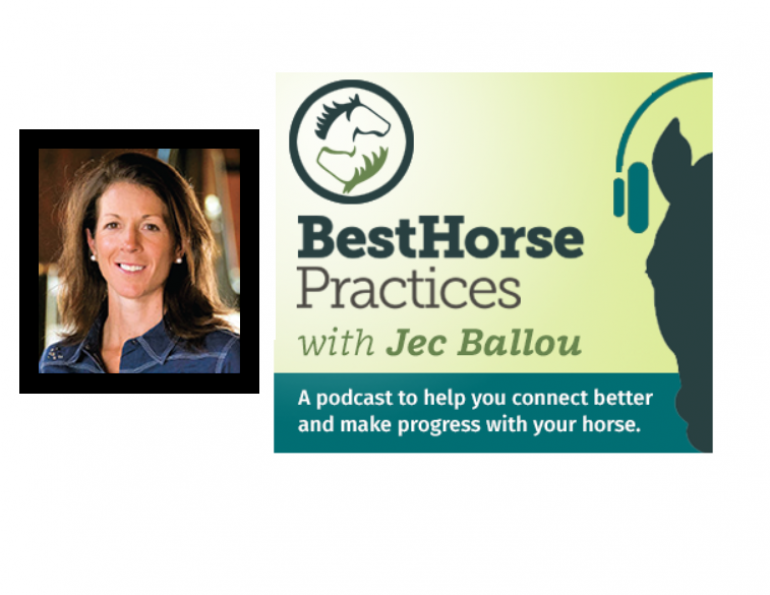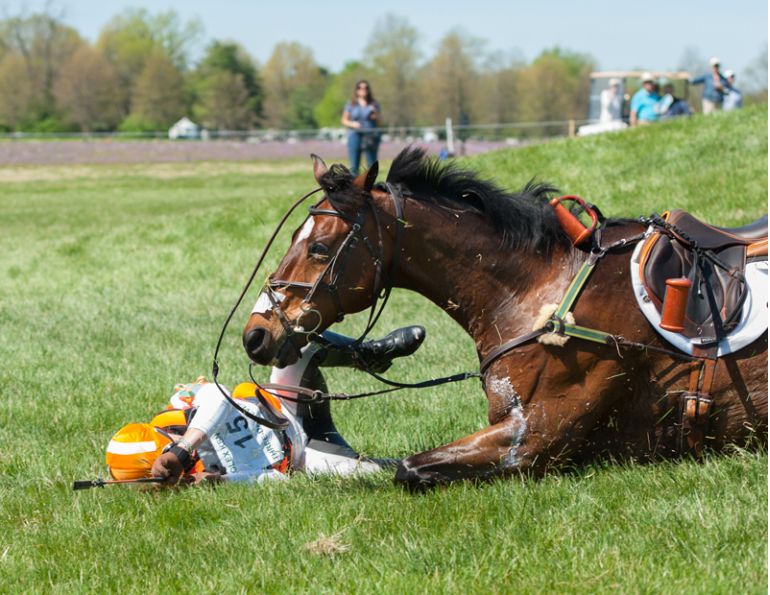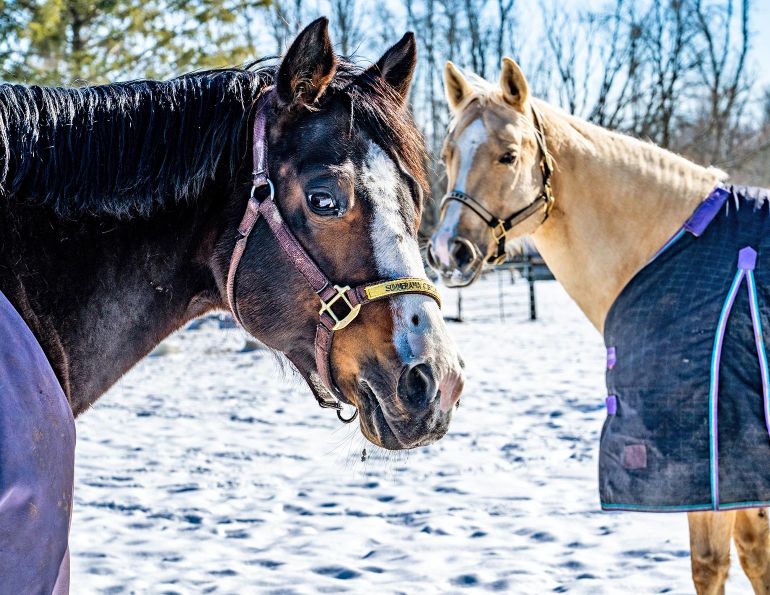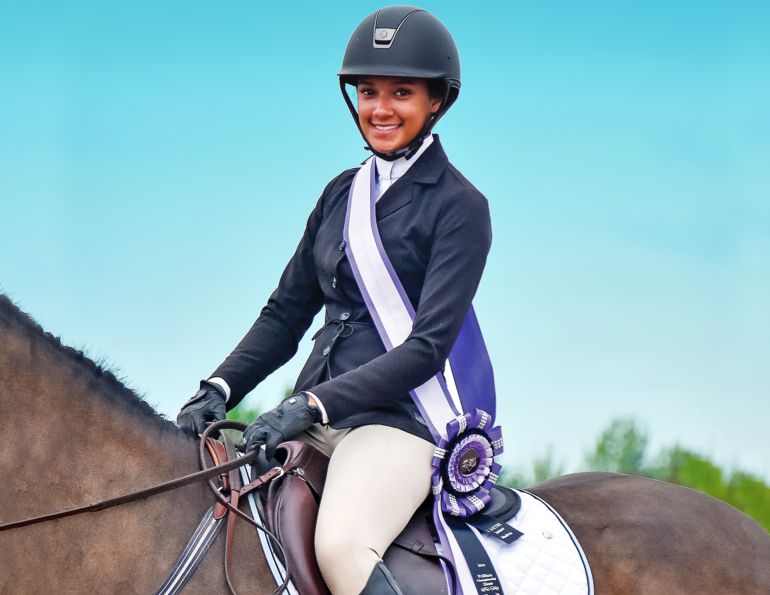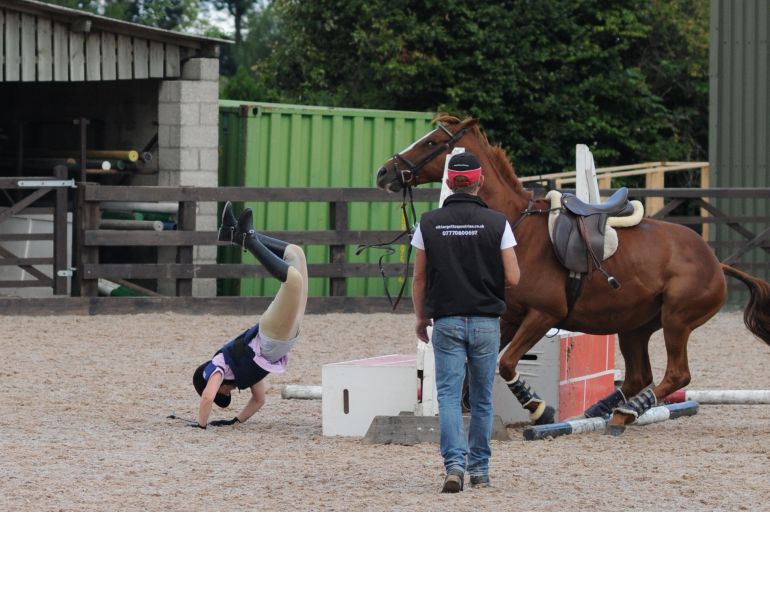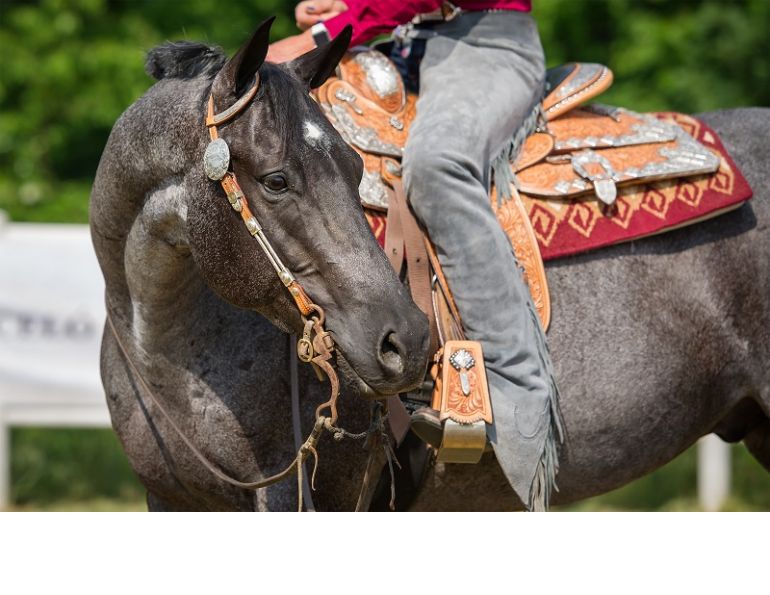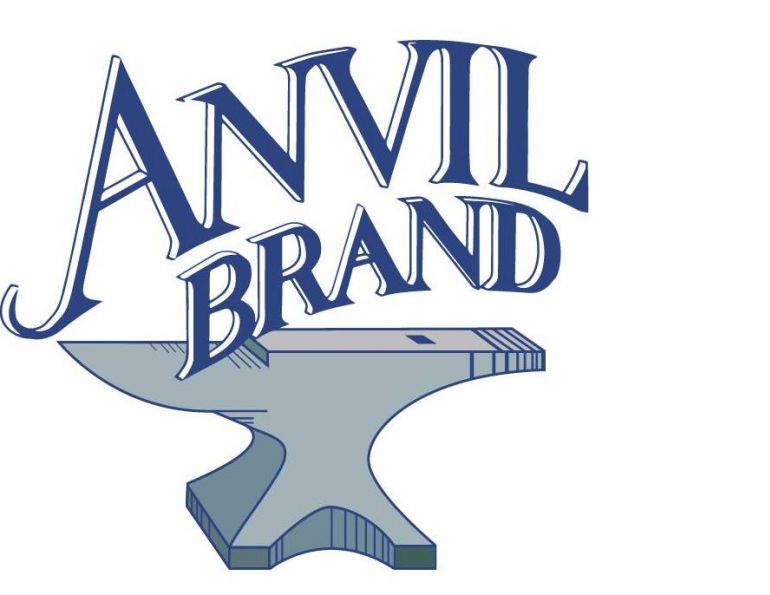Riding Accidents and Concussions
By Margaret Evans
Head injuries are the most common reason for admission to hospital or death among riders. Sobering statistics reveal the high percentage of equine-related accidents resulting in traumatic brain injury, and helmets have been associated with reducing the risk of traumatic brain injury by as much as 50 percent. Yet many riders still do not wear a helmet.
In 2010, Florida-based Olympic dressage rider Courtney King-Dye was hospitalized with a fractured skull and coma after her horse fell when his legs slipped out from under him during a schooling session at home. She wasn’t wearing a helmet.
A riderless horse returned to its boarding stable in Washington State. A fellow rider went looking for the missing equestrian and found her body a mile away on a gravel road. She had fallen off, suffered head trauma and died where she lay. She wasn’t wearing a helmet.
In 2005, Ontario barrel racer Patricia Moore died from severe head injuries when her horse stumbled and fell after leaving the ring. Moore was not wearing a helmet.
Ten-year-old Elizabeth Hader of Ontario was killed when thrown from a horse that spooked at a public trail riding facility. She suffered severe head injuries and police confirmed that she was not wearing a helmet.
In 2016, barrel racer and Florida rodeo queen Lara Dewees lost her reins when her horse fell during a competition. The horse recovered, finished the barrels and ran through the arena exit only to slip on the asphalt causing Dewees, still without her reins, to be thrown to the ground where she landed on her face. Shortly after, she died from a blood clot to her brain.
Horses are big animals and they can do big damage. Contrary to what some people think, there is no such thing as a bombproof horse. Any number of situations happening in a nanosecond can trigger a well-behaved, compliant, dependable horse to erupt into a panicking, flight-driven animal from which the rider can fall or people can be crushed or trampled as the horse runs into or over anyone in its path. And horses can just as easily stumble or trip, sending a rider headfirst to the ground.
Related: Straighten Your Horse for a Safer Ride Over Fences
Head injuries are the most common reason for admission to hospital or death among riders. A fall from 60 cm (two feet) can cause permanent brain damage, yet a horse will elevate a rider’s head up to three metres (more than eight feet) above the ground. When travelling at seven to ten kilometres per hour the human skull can shatter on impact, yet horses can gallop at 60 kilometres per hour. A rider who has had one head injury has a 40 percent chance of suffering a second head injury. Children, teens, and young adults are most vulnerable to sudden death from a second concussion. While death can be the ultimate outcome of a catastrophic accident, those who survive with traumatic brain injury (TBI) may suffer epilepsy, intellectual and memory impairment, speech problems, confusion, depression, personality changes, emotional changes, and post-traumatic stress disorder. By any score, a head injury is a life-altering event.
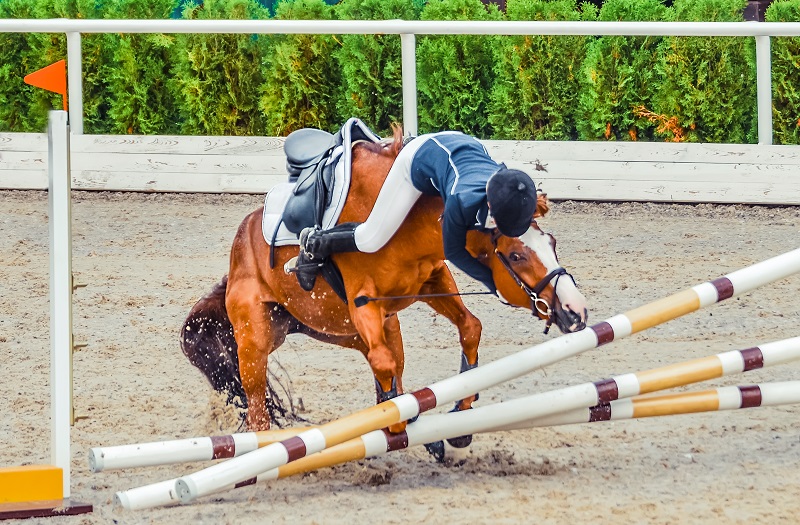
When horse and rider part company, the rider’s head is usually first to hit the ground. Photo: Shutterstock/Taylon
What is Concussion or Traumatic Brain Injury?
The website Parachute, dedicated to preventing injuries and saving lives, explains that when a person suffers a concussion, the brain suddenly shifts or shakes inside the skull and can knock against its bony surface. The blow that causes the brain to collide with the skull may be to the head or the body, but it is the force of the blow that does the damage. The brain can be bruised, or the brain can react with a rotational twist that causes shearing or tearing of the nerve fibres as well as bleeding. The shock can cause a change in the brain’s chemical function. No two brain injuries are alike and symptoms are highly variable, lasting days, months, or years.
According to the Northern Brain Injury Association (NBIA), injuries to the brain are among the most likely to result in permanent disability or death. In British Columbia, brain injury occurs at a rate greater than all known cases of multiple sclerosis, spinal cord injury, HIV/AIDS, and breast cancer combined, per year. According to the NBIA website, 452 people suffer a serious brain injury every day in Canada.
Related: The Psychology of a Concussion
Historically, based on a research study on equestrian injuries done by Dr. Janet Sorli and published in 2000 in the journal Injury Prevention, data from the BC Ministry of Health from 1991 to 1996 showed that there were 1,950 hospital admissions, a mean rate of 390 per year. Fifteen people died, nine from head injuries. Sixty percent of the deceased were females varying in age from four to seventy-one years of age. None of those dying of head injury had worn a helmet.
Looking at data from the National Trauma Data Bank between 2003 and 2012, researchers with the Department of Neurological Surgery, University of California, San Francisco, and the Brain and Spinal Injury Center, San Francisco General Hospital found that equestrian and equine-related sports were the largest contributor to sports-related TBI in adults and accounted for more than 50 percent of all TBIs in those older than 40 years. Their report, “Adult sports-related traumatic brain injury in United States trauma centers,” was published in Neurosurgical Focus in April 2016.
This finding, the researchers wrote, is consistent with those in previous reports indicating greater rates of severe traumatic injury in equestrian and related sports than football, rugby, and skiing, and higher rates of hospital admission than other high-risk activities such as motorcycle riding. According to the US Centers for Disease Control and Prevention, while motorcycle riders experience a serious injury every 7,000 hours of riding, horse riders experience one every 350 hours.
In the UC San Francisco study, the researchers said that rates of helmet use are 25 percent or lower across equestrian sports, despite the fact that helmets have been associated with as much as a 40 to 50 percent reduction in absolute risk for TBI.
The comparison of equestrian head injuries to those in other sports or contact accidents is sobering. The research states that equestrian and related sports accounted for the greatest number of sports-related TBI at 45.2 percent. Falls or interpersonal contact was 20.3 percent, roller sports came in at 19.0 percent, skiing/snowboarding was at 12.0 percent, and aquatic sports was 3.5 percent.
Those findings are consistent with the report “Ten years of major equestrian injury: Are we addressing functional outcomes?” published in the February 2009 issue of the Journal of Trauma Management & Outcomes. Written by occupational therapist Jill Ball and a team of health professionals with the University of Calgary, the Foothills Medical Centre and the Calgary Health Region, they explored the outcomes of severe and serious equestrian injuries.
In the study period 1995 to 2005, they reviewed all trauma patients and identified 151 injured when horse riding. Ten died, all from catastrophic head injuries. Of the remaining 141, all had a mean injury severity score (ISS) of 20 (major trauma) as a direct result of their injuries. While 55 percent of the riders and their horses were experienced and well trained, only nine percent of the riders wore helmets.
Related: Barn Safety Tips - Plan Ahead to Improve Your Chances of a Positive Outcome
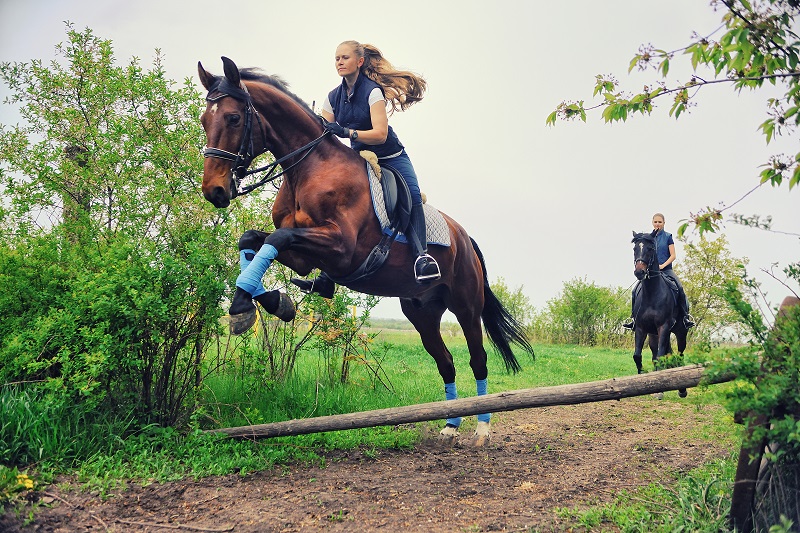
Research shows that as the use of riding helmets increases, fewer riders will suffer severe head injuries. Photo: Shutterstock/Pirita
The symptoms of a concussion or TBI often fall into four categories:
- Thinking clearly, remembering things, or concentrating on topics becomes challenging.
- Physical symptoms include headaches that won’t go away, nausea/vomiting, balance problems, dizziness, blurred vision, tiredness, sensitivity to noise or light, and ringing in the ears.
- Emotional changes may include irritability, sadness, depression, or anxiety.
- Sleep problems can include difficulty falling asleep or sleeping longer or shorter periods of time.
These symptoms may show immediately or they may not surface for days or weeks. If they are subtle they may be missed by family, friends, or the doctor.
Following a concussion, brain cells and brain function remain highly vulnerable and are at risk of a second head injury. If a rider returns to equestrian activities before the first concussion has properly healed and they suffer a second concussion, they are at risk of a longer recovery time and worse outcomes including post-concussion syndrome, a complex disorder in which the symptoms of headaches and dizziness can last much longer. It is therefore critical that they abstain from riding or risk-prone activities until cleared to do so by their doctor.
Accident Response
If you are at the barn riding, or taking part in a lesson or clinic, be aware that anything can happen at any moment. Several years ago, I was hosting a riding clinic at my facility. All the riders were juveniles and teenagers and there were two groups registered with six riders in each group. One of the riders came with a horse she was unfamiliar with. She was trying it out to see if it was suitable for her. Red flags went up. A riding clinic is no place to try out a strange horse. The rider and the horse didn’t know each other and the horse was in a strange place. Sure enough, the horse had a panic attack, bucked off its rider and bolted around the warm-up ring. The rider suffered a broken arm. The incident upset other riders in the group and an acclaimed “bombproof” pony then also acted up, bucking off its already nervous young rider who suffered a fractured wrist.
The incidents serve not to cast blame but to illustrate the fact that any number of triggers can set off a chain reaction that can result in accidents and injuries. All the riders were wearing helmets and fortunately, the injuries were relatively minor.
Related: 20 Tips for Safe Trail Travel with Horses
The following is a checklist of what should be done if someone falls from a horse in a riding ring:
- Stop all activity.
- Call 911.
- Do not move the fallen rider and do not allow him/her to move.
- Do not remove the helmet.
- If conscious, ask him/her where they feel pain.
- If not responding, touch, rub or pinch the patient’s skin to elicit a response. Do not shake the patient in case a spinal injury is present.
- If not breathing, ensure the airway is open by opening the mouth.
- Feel for a pulse in the neck or wrist. If no pulse, start CPR only if you are trained.
- Check for any bleeding around the head or face or any clear fluid draining from the nose or ears.
- Keep the patient warm.
- If a wound is bleeding apply pressure with a clean towel.
- If the rider is a minor, notify the parent/guardian.
- Have someone secure the loose horse.
- Have all other riders leave the arena.
- Have someone make sure there is clear access for paramedics to reach the patient.
Even if the rider jumps up and claims to be feeling fine, have them sit down, rest, and not remount. Don’t let them brush off the incident. Adrenaline can mask injuries that are not obviously apparent. There could be internal bleeding. Suggest that they get checked out at their doctor’s office or the emergency department at the local hospital. Don’t let them take chances.
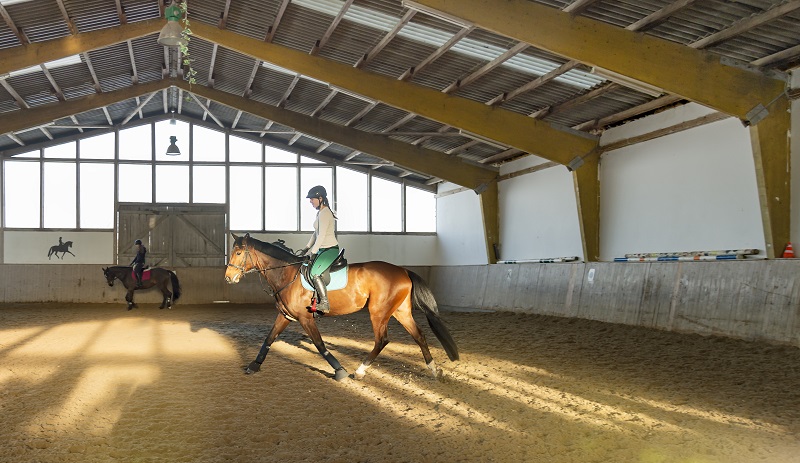
If a riding accident occurs while riding with others in an arena, all riders should immediately stop. The condition of the fallen rider should be assessed and the loose horse should be quietly caught. After a fall, the old saying is to get back on, but this should ONLY be allowed after making sure the rider is unhurt and after analyzing what went wrong. Photo: Shutterstock/Tanya Esser
Trail Riding
A medical emergency gets a lot more complicated when trail riding even local trails.
For safety’s sake, ride with a friend. Tell someone at home where you are going, what trail(s) you are taking, and what time you plan to be back. Take your cell phone and make sure it is fully charged. Pack a first aid kit for both yourself and your horse. Pack bottled water, a snack, a whistle, waterproof matches or lighter, an emergency knife such as a Swiss Army knife, a jacket, a GPS device, a hoof pick, and medications for pain or cuts. Check the weather before leaving and dress appropriately. Wear a zippered vest or jacket in which to keep your phone, personal details (name, address, medical information, next of kin, phone number), emergency contact, and whistle. They are no help to you if they are packed in the saddle bag and you become separated from your horse. Put a halter on your horse underneath the bridle and secure the shank. Teach your horse to stop with dropped reins.
A few additional guidelines include:
- Ride a suitable horse that matches your skill level.
- If riding a green horse, ride with a companion on familiar trails.
- When riding in a group, keep one horse length between horses so that if a horse kicks, the rider behind won’t be struck by accident.
- Don’t race or ride at a pace too fast for the conditions. Ride at the speed of your least capable companion or green horse.
- Learn how to fall or do an emergency dismount.
- Wear all safety equipment – helmet, safety vest, boots with a heel, safety stirrups or stirrups with cages.
- Walk the last mile home.
If you are riding in the evening or in low light (not the wisest plan) stick to known trails, keep the pace at a walk so you have enough time to see hazards in front of you including low branches that can knock you off the horse, pack a flashlight or wear a headlamp on your helmet, consider a clip-on LED light your horse can wear, avoid riding on the road where headlights can confuse a horse, and wear reflective gear.
Remember that wildlife is often on the move during the evening or at night, so be aware that you may have a potential encounter with a bear or cougar that your horse will very likely spook at. Even a deer obscured in the darkness will give a horse cause to pause. By riding with a friend, your own horse will feel a lot more comfortable with the other horse alongside. If something happens on the trail you can help each other and, if you are in cellphone range, one of you can call for help.
The lure of backcountry is immense. Powerful vistas, a glimpse of iconic wildlife, camping beneath the stars, or the call of a loon from a glassy lake at dawn are irresistible. But there are dangers and nature is a harsh taskmaster. Know the rules. Prepare for potential eventualities.
If you are planning an extended backcountry trip, make some cautionary plans with your family. They need to know your route, intended campsites, and your estimated rate of travel so they can calculate where you should be at any moment during the elapsed time since leaving. If something has happened and you don’t return at the intended time, your planned ride details will be essential for Search & Rescue. Except in the case of an unexpected event such as, for instance, a blocked trail due to an avalanche or rockslide, don’t deviate from the planned route. Before leaving, think through an emergency plan and leave it with your family.
Know enough about yourself and your horse to know when you’re over-faced and that you should turn around and return. It could be fatigue, a few nagging injuries, a lameness issue, overheating (in which case get in the shade, rest, apply a damp towel to your face, neck and chest, and drink water slowly), severe weather changes, or unexpected conditions such as swollen rivers and streams too dangerous to cross.
Related: How to Select and Fit an Equestrian Riding Helmet
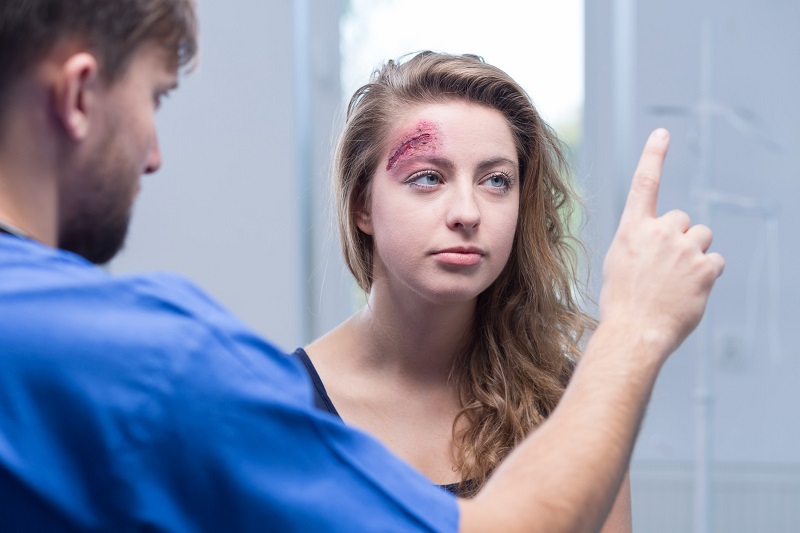
Symptoms of concussion can include memory loss, dizziness, blurred vision, headaches, ringing in the ears, and depression. The signs can be subtle, and may not show immediately or for several days or weeks. Photo: Canstock/Bialasiewicz
If you are out of cellphone range and encounter other riders or hikers on your journey, take a moment to stop and greet them. If necessary, you could give them your home number and ask them to give your family a call to let them know all is well or any other important information you want to convey.
In addition to the items needed for a local trail ride, additional items to pack for a backcountry or overnight ride include a hydration water pack, water purification tablets, pen flare kit with bear bangers and multi-coloured flares, heavy-duty Ziplock® bags to keep essentials dry, and a survival kit.
Decades ago, before the age of cellphones, I was 30 kilometres inside Banff National Park filming bighorn sheep at a salt lick in late summer. A lone rider came by my campsite. He was in his fifties and riding a Quarter Horse with a dependable pack horse alongside. He was on a backcountry ride from Banff to Jasper. He stopped and rested and we talked for a while. He had had some delays getting started in Banff and was behind schedule. He knew his wife would worry if he didn’t arrive in Jasper at the appointed time. Since I was going home in a few days I promised him I would call her, tell her all was well, where he was, and that he’d be a few days late. She was so grateful when I made that call.
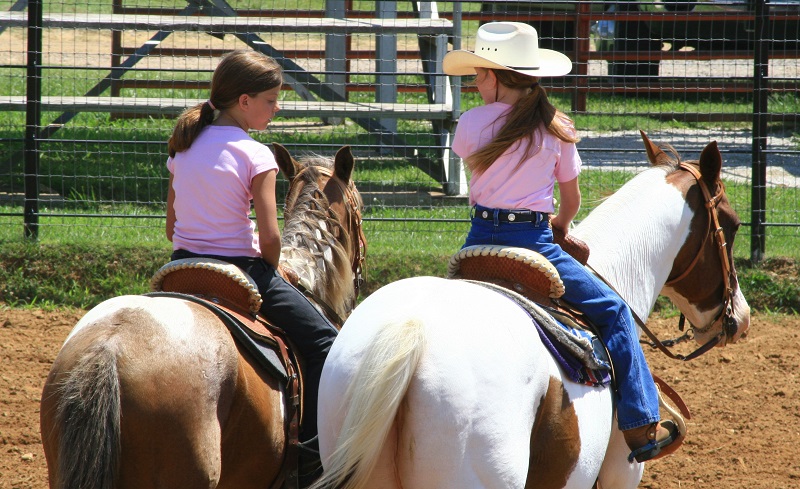
When the United States Pony Club tightened its regulations for headgear, concussions were reduced by 29 percent and head injuries by 26 percent.
There is an unspoken code among backcountry travellers that folks look out for each other. Enough things can go wrong that any shared information may be the difference between life and death.
Horses, fabulous though they are, can stumble, slip, spook, buck, bolt and fall, and their innate instinct to flee from danger is as strong as it was in their ancestors. Be proactive. Use caution. By being aware of the dangers and proactively reducing your risk, you can make a world of difference in preventing an accident or reducing its severity should one occur.
Safety Gear and Equipment
Riding helmets
The riding helmet is the most important part of riding equipment. There are absolutely no excuses not to wear a helmet and it should be in place and secured before mounting.
Some years ago, a friend had mounted and was putting her helmet on but had not fastened it when her horse reared. She fell off backwards, landing on her head on the concrete driveway and sustained permanent memory and functional issues.
Ideally, a helmet should be worn even when working around or in close contact with any horse. Many injuries happen when working with horses on the ground. A tied horse can startle and jump sideways, knocking the handler to the ground where they are at risk of being stepped on.
Related: How to Make a First Aid Kit for Horses
Replace your helmet every five years, replace it after just one fall, and never share it. When shopping for a helmet, check the date of manufacture and verify that it is made to ASTM (American Society for Testing and Materials) standard and certified by SEI (Safety Equipment Institute) or Snell3 (Snell Memorial Foundation).

Both horse and rider should wear reflective gear when riding on the roads and trails, and whenever riding in low light and during hunting season. High visibility clothing, such as this helmet cover and fly bonnet from Heads Up Clothing in Ontario, is one more way to reduce risk. Photos courtesy of Heads Up Clothing.
Protective vest
The choice of vest a rider selects will depend on style, quality, and the kind of riding they do. The purpose of the vest is to protect vital organs and soft tissue from injury in the event of a fall. Vests are not meant to be life-saving devices, but they can help soften the blow and an accredited vest meets ASTM/SEI standards of safety.
Boots
Boots with a heel are essential to protect your foot and leg (if wearing a long boot) when riding in the bush, and to prevent the foot from slipping through the stirrup.
Chaps
Chaps are perfect for trail or bush riding. They prevent scratches and tears to jeans and breeches. They prevent chaffing against the saddle and pinching from stirrup leathers.
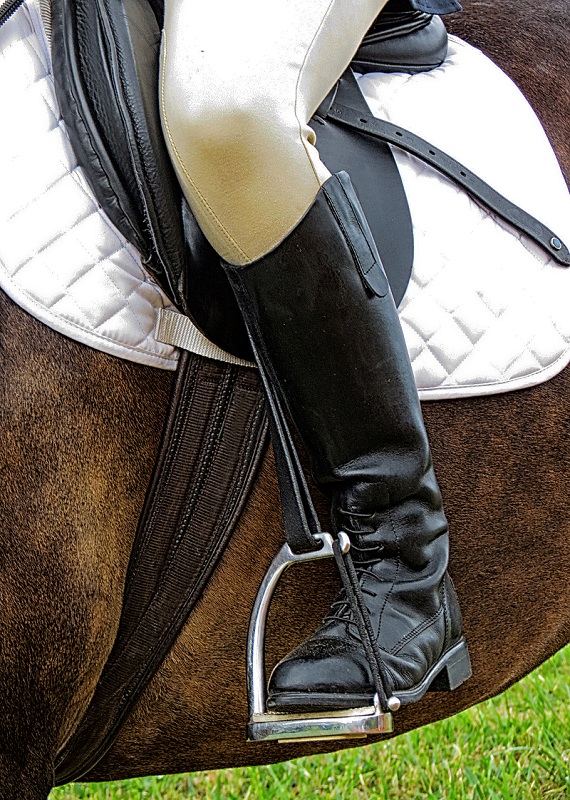
Safety stirrups reduce the chance of the rider’s foot being caught in the stirrup and being dragged in the event of a fall from the horse. Photo: Thinkstock/Nic54
Gloves protect and provide warmth to hands and offer better grip when holding the reins, especially if the horse pulls. Leather-palmed gloves are ideal and they can come in different styles according to summer or winter. What matters is that you can hold the reins comfortably.
Stirrups and toe stoppers
Stirrup irons come in a wide variety of styles and sizes and their designs have evolved over time. There are the traditional Fillis iron to breakaway stirrups for emergency release, and those that can ease joint pain or are designed for specific competitions. They can be fitted with rubber inserts for greater boot grip and can be rubber-cushioned in a wider foot base for endurance riding. Breakaway stirrups are made of stainless steel with a heavy rubber band down one side and they are designed to lessen the risk of a foot getting caught. Toe stoppers or cages prevent the toe from sliding through the stirrup and can be attached to an existing stirrup iron.
Reflective equipment for horse and rider
The whole point of reflective equipment is to be seen. Horses can be fitted with reflective brow bands, nose bands, reins, saddle pads, quarter sheets, leg wraps, bell boots, breast plates and tail wraps. Riders can take advantage of helmet covers, vests, and jackets with reflective stripes.
Poll: Have you had a concussion or head injury from a riding accident?
Related: 11 Reasons Not to Wear a Riding Helmet
Photo: Shutterstock/Steve Horsley



